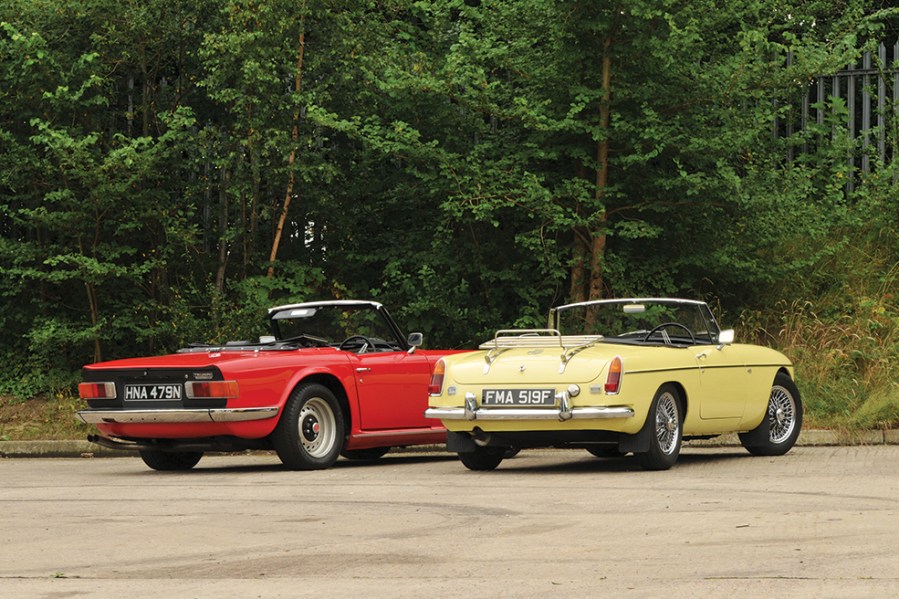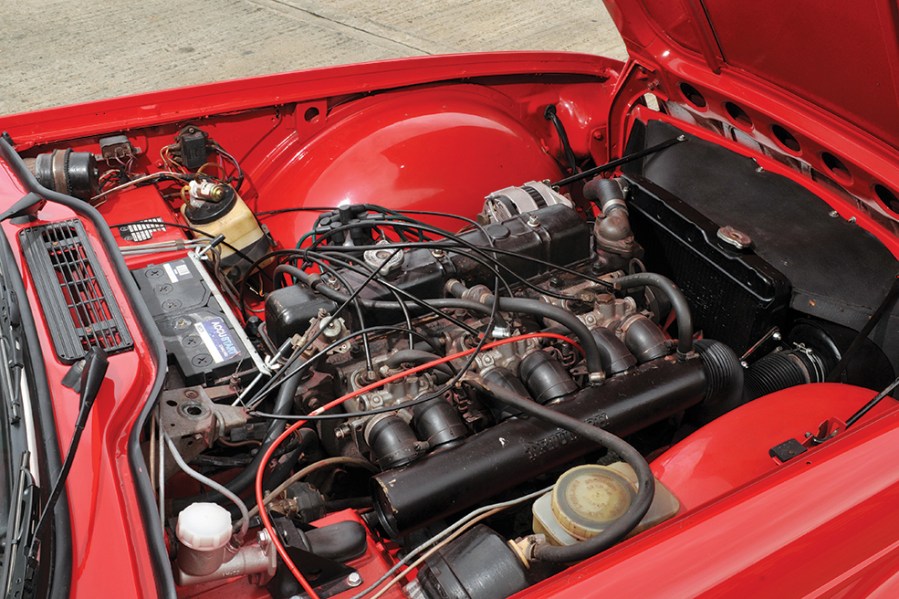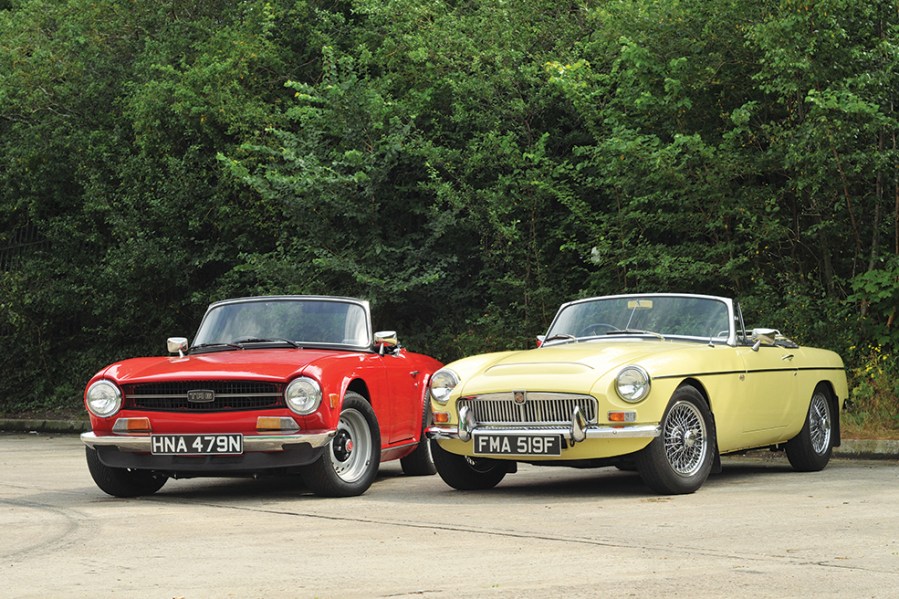If you’re after six cylinders under the bonnet of your traditional British sports car, both TR6 and MGC make a compelling case for themselves
Words: Aaron McKay
The British sports car offers classic style, hands-on sporting feel, and a full-bodied soundtrack almost no matter which you choose. Anything from a pokey MG Midget to a svelte Jaguar E-type will deliver these qualities, in different amounts of course. Found somewhere in the middle are the MGC and TR6. They are both products of the 1960s, both genuinely sporting machines, and both enjoy the cultured tune of six-cylinders lined up under their bonnets. However, even if BLMC did find MG and Triumph too close to each other, these two are actually rather different. Not just were they borne of different circumstances, but they also have their own driving experiences.
The MGC arrived in 1967, itself a product of conglomeration with another sports car maker, Austin-Healey. The original idea had been, rather optimistically, to develop an entirely new Austin-Healey model along with a sister MG car, as per the Sprite and Midget relationship. It would conveniently use up the 4.0-litre Rolls-Royce engines for which the Austin Princess 4-Litre R had failed to generate enough volume demand. A by-product of the project would be to fit the MGB with a smaller six-cylinder engine, therefore fully rounding out the range. However, this idea of a new sports car was eventually kiboshed and, ultimately, only the six-cylinder MGC survived. Not that, as they discovered, this was such a simple task either.
Deciding exactly which engine wasn’t without some considerable thought. The initial plan was to use the 2433cc ‘Blue Streak’ six-cylinder B-series already employed in Australia. After some deliberation, it was decided that the Austin-Healey 2912cc would be crammed in somehow. A higher bonnet was a given, clearing the larger radiator and higher carburettors, but much more extensive modification was required underneath. This began with a new floor pan and suspension design. Instead of coil springs, torsion bars were instead secured to reinforced structures just below the seats while a new cross-member routed itself around the lower sump. Forged lower wishbones and telescopic dampers completed the setup. The spring rate was increased to control the extra weight of the engine, but there was a ride quality benefit gained here thanks in part to the use of telescopic dampers. The steering ratio was also changed, upping the turns lock-to-lock to 3.5 from the MGB’s 2.9. The MGC did indeed weigh 156kg more than the MGB, of which 95kg was the engine.
The engine itself was familiar to drivers of the Austin-Healey 3000. The basic facts seem largely unchanged: same displacement, 3bhp less powerful but a gain of 5lb.ft of torque. However, MG engineers did work hard at refining the very last ounce of development out of this engine, one which dated back to a 1948 Morris Engines design. The block and cylinder head castings were redesigned, made stronger, and aluminium ancillary castings were used in preference to steel where possible. Seven, smaller bearings and revised manifolds also went towards promoting a freer-revving character. However, much like the 9kg weight saving achieved, improvements were disappointingly incremental. Some good news was that the stronger design meant that competition cars could handle 200bhp and, indeed, the MGC did see quite a bit of rallying action.
Triumph was also facing difficulties developing its sports cars through the 1960s. There was enthusiasm in the company, demonstrated by the Fury concept showcasing a monocoque chassis, low-slung looks and a six-cylinder engine, but the confines of a tight budget hampered most exciting ideas like this. However, the lesson that the 1998cc six had been packaged in a sports car stuck and so the TR5 was born. The TR5 was a short-lived car, effectively a TR4A with the new, Triumph big-six installed, but it secured another life for the TR-series of sports cars. The clay model for the TR6 received board approval in September 1967, just as the TR5 was launched. Triumph didn’t have half the problems fitting in the larger engine as did MG.

The big-six at the heart of the TR6 was carried over from the TR5. It’s a curiously oversquare engine, hinting at how very far it has come from its beginnings as a 200cc per cylinder unit from the early 1950s. Its first guise was as a four-cylinder, developing into a six-cylinder in 1960, by which time it had already been bored out to achieve a 1998cc total capacity. Achieving a power figure substantially higher than the 95bhp as seen in the Triumph GT6 for TR6 requirements, meant lengthening the stroke to bring it up to 2498cc.
A considerable amount of effort also went into improving the breathing performance of the six, with new camshaft profiles, revised manifolds and so on. The most significant development, of course, was the use of Lucas Mk2 fuel injection. This in itself unlocked a good 10bhp or more, though in the case of comparing US-spec’ twin-carb models with European-spec fuel injected ones, that’s more like 45bhp. In fact, it was all Triumph could do to maintain the US-spec cars’ 106bhp against ever tightening US emission controls through the TR6’s lifespan.
Behind the TR6’s engine lay pretty much the same chassis as had underpinned the TR2 back in the 1950s, the most major change since then being the coil sprung rear axle using semi-trailing arms. That said, myriad detail changes through the years meant that the body-on-frame TR6 was far from shamed by the dynamic resolve of the MGC. By the time of the TR4A, Triumph had reinforced the chassis considerably and tweaked the suspension geometry just so. The TR6 was another step on, notably being the first TR sports car with a wider rear track than front – the MGC matches the TR6’s 1251mm rear track width on both axles. The structure was also strengthened to suit the increased stresses of the six-cylinder, including a new turret cross-brace, rather than any additional weight – in fact, the big-six is a fraction lighter than the four.
The German manufacturer Karmann was responsible for the redesign of the TR5 into the TR6 and, compared with the MGC or the TR5, its squared-off edges make it look aggressive, even butch. However, it’s hardly 15kg heavier than the MGC despite being longer and wider, and it does in fact retain the doors and all internal body panels of the TR5. The Triumph is a case of a dramatic result from minimal input, including an incredibly short lead time for Karmann of just 14 months from commission to delivery. The MGC, on the other hand, is the picture of elegance kept true despite all the change that’s gone on underneath. Only the power bulge in the bonnet and a subtly altered stance speak to the new engine and suspension. For many, the MGC badge at the rear will be the first they know of this not being an MGB, which is certainly no bad thing.
Each car looks at you differently. The TR6 is almost spoiling for a fight with its furrowed brow, and it certainly speaks to those in the mood for a serious drive. The MGC, meanwhile, quietly invites you into its world of 1960s glamour. Its delicate lines and flashes of chrome create their own rose-tint. Inside the MG is simple. The dashboard is short and curves around with the screen, creating just enough space for toggle switches in the centre. Charming Smiths dials are set into the mottled dashboard face, grouped inside the 16.5” rim of the steering wheel. Apart from navigating this particularly unwieldy item, you quickly find yourself comfortable and at ease in the MGC.

It’s clear there’s a big engine turning over under that power-bulge bonnet and, on start-up, it takes a few stabs of the throttle to settle down. Then it’s not much more than a murmur and hardly needs much stirring to get the car underway. Going into third gear early soon becomes common practice, where the six hauls through its torque curve and builds up a satisfyingly rich engine note. From 30mph you can often surprise modern traffic with the sheer ease you’ll leave them behind, and even going into fourth doesn’t dip acceleration much. In fact, keep it going and the MGC will happily move the speedo well up into its higher reaches.
The MGC’s chassis and suspension are more than up to the job of containing high speed cruising and provide good comfort too. The front soaks up bumps especially well both in town and on more open roads, and those sharper impacts that do get through hardly ever shake the cabin. Soft bucket seats, a quiet cabin roof up or down, and long gearing add up to make this a wonderful place to spend time in. You’re just left to enjoy snicking through the gears, metering out notes of the engine, and gliding that sculpted bonnet along country roads.
Most of the MGB’s much-loved handling delicacy is here too. There’s an undeniable sense of driving the car from the rear axle while the front feels light and involved. There is a fine edge that’s been lost but you’d be pushed to put a finger on it without the experience of an MGB fresh in the mind. What’s most obvious is the slower steering rack, now 3.5 turns lock to lock from the B’s standard 2.9. You can find yourself twirling this big steering wheel around frantically, which upsets the car’s otherwise calm and collected behaviour.
Wind the C-series out and it does make a fine noise, just as it does in the Austin-Healeys of old. It’s not quite as razor sharp as in those cars, feeling weighed down by a flywheel that gives it a more refined edge in the MGC, but it certainly gets the car up and going. Acceleration is strong and doesn’t tail off until you’re in serious danger of scaring other road users. Try the brakes and you might scare yourself, too, as the front discs and drums are only slightly larger than the MGB’s, and the brake pedal is a bit mushy. Then, while the slightly ponderous steering is quite manageable midway through a corner, it can present a challenge finding a positive bite when piling into a corner hard on the brakes. Get it all right and you’ll find a rhythm, the MGC showing fine balance and composure, especially if fitted with modern dampers, but it can be hard work if you push too hard. The car prefers to be hustled, not raced. Cruised, even better.
Not so the TR6. You sit much lower here and there’s more of a sense of strapping yourself in. The dashboard is flat and, compared with the MGC’s, almost imposing as it faces you with a vast expanse of wood veneer and instruments including oil pressure and voltage gauges. The seats also feel slightly thinner, though still comfortable and trimmed in a vinyl similar to the MGC’s. You are, then, in a state of mind to fire up the TR6, not just spin it up, and it tends to deliver an appropriately bellowing burst of life. For the first few moments it can sit lumpier than the MGC’s six, despite its fuel injection, but then it irons out into a deep, silky tone.

There’s more going on right from the off in the TR6. You can hear the odd stone flicking into the wheelarches and feel more of the road surface through the seat. The exhaust note is ever-present and only gets stronger with the throttle, and the engine itself feels much lighter under foot and keener to go. Let it go in second gear and it’ll shoot up the revs with a voracious appetite, such that it comes at a surprise that it runs out of puff very soon after its peak power of 150bhp at 5500rpm. While the MGC seems, on paper, somewhat lazier with its 145bhp peak at 5250rpm and a higher torque figure lower down, the TR6 is the one which more noticeably hits a wall of inertia at the top end.
Load up another gear in the rifle-bolt type box, however, and the TR6 continues hurtling down the road with a bassy roar from the exhaust – made even better with a stainless steel piece. With its shorter gear ratios, you’ll need forth gear soon enough. Despite brakes of very similar size and a steering ratio also of 3.5 turns lock to lock, the TR6 inspires much more confidence containing its performance. The brake pedal is sharper in response and more detailed through its travel while the smaller, 14” steering wheel makes a considerable difference in how wieldy the car feels. Quicker steering racks are a popular upgrade, nonetheless.
The TR6 is more fidgety on country roads than the MGC, lacking that car’s ability to filter out bumps. Instead the Triumph bobs over imperfections and weaves into cambers, but while it’s certainly more of a handful the TR6 ultimately stays tied down. Commit it into corners with the throttle and you can enjoy fantastic balance between the axles, then just let the engine free onto the next straight. It’s a car that encourages you to drive fast and involves you in every part of the experience. To cruise along almost feels like a waste of time or, at the very least, an intermission.
The TR6 can tour well enough and, like the MGC, it’s astonishing how much can be achieved in both ride and handling with the latest suspension components. In fact, both these cars can be set up for almost whatever you’d like to use them for. They do have their inherent advantages however, with the MGC being a natural cruiser and delicate handler, while the TR6 is a hands-on fireball. These detail qualities will be worth any prospective owners considering, that is if they haven’t already decided by the styling. The MGC is undoubtedly more beautiful but then the TR6 is sharp and distinctive in its own way. Then there’s the history, where the TR6 represents the last of an era and the MGC a curious by-product in a what-if story. Their narratives also lead to the fact that ten times as many TR6s were made than MGCs, that’s 9002 vs 91,850 (and only half of those MGCs are roadsters).
Both these cars have endured years of underappreciation. They’re both excellent cars worthy of great consideration and are certainly promising investments. As for which one I’d choose today, well I’m in a contemplative mood over the legendary British sports car so I’ll take the MGC to savour and ponder the idea. Perhaps when I return from a drive in that, I’ll be well in the mood for a blast in the TR6.























